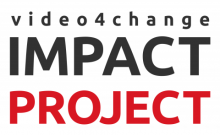Is It All About Creating Impact?

Today, audiovisual recording devices are everywhere. But does picking one up and hitting record necessarily mean creating an impact? Are people generally concerned, or even aware, of the impact a video can have?
The omnipresence of the camera in our modern world surely has an impact. But I daresay, we are just beginning to understand what this impact is. Mainly because it’s happening right here and now, at a frantic pace and in incomprehensible amounts. YouTube’s statistics only get more mindboggling each year. Therefore, we should focus on the real measurable impact of videos, instead of trying to understand the incomprehensible, however interesting it may be to all the academics and philosophers out there.
With so much video going around, and only so many viewers, it's a challenge to be seen. Video for Change practitioners all over the world are taking up that challenge, believing their videos are making real impact. The video4change network, which aims to support all practitioners in the field, is trying to help make this belief tangible. As it is said: Measuring is knowing.
Over the past two years, we have put much time and effort into researching and defining the impact of video. One of the key things we've learned is that contributions to impact don't occur at any given moment. Instead, they happen all along the many processes and actions throughout the duration of a Video for Change project or initiative. Also, audiences for a video don't just appear. They need to be created. Most important of all, and this underlies all aspects of the work, is every Video for Change practitioner's obligation to work ethically.
What good is a video with a million hits if it harms the people in it? Can a video claim to talk about a local community if certain groups were not given the chance to appear in it? What should we do with statements made in front of a camera which clearly discriminate others? The answers to these questions may be blowing in the wind, but there is a strong need for guidance, sharing and overview on the many ethical issues regarding Video for Change. Yes, impact creation and measurement needs to be built into Video for Change projects, but it's not all about impact. The intrinsic value of the impact needs to be taken in account.

The video4change network is developing a toolkit for practitioners that puts most impact-related ethical concerns into perspective. We've divided them into various categories, while collecting as many case studies as possible to complement the theory. Please do share yours.
Despite all the nuances and necessary categorization needed to address ethical concerns surrounding impact, working ethically as a Video for Change practitioner boils down to two simple things:
-
Being responsible as a human being
-
Being accountable as a professional
And even these two, often bring about very complex and sometimes conflicting situations. A simple example: Imagine trying to get from one shooting location to another, and an important member of the community you're working with offers you a ride in their car. Despite being an experienced driver, he has no driver's license. Refusing the ride and renting an outside vehicle will surely harm your relationship with the community, but if anything happens during the ride, the funders of your project will seriously question your accountability for knowingly accepting a ride from someone without a license. What do you do?
Cases like these will always occur when we're out there in the field producing videos. More often than not, there is no “right” decision. Even the best decisions can only be made one unique case at a time. Working with real people, tackling real issues, looking our subject directly in the eye, we can't always hide behind regulations and rules. What the Video for Change Impact Toolkit tries to do, is offer insight and overview. Through examples, reminders, and lists of questions you could ask, we hope that working responsible and accountable can get a little bit easier. In the end, the difficult, defining decisions are made in the field and with little time to think, so we'd better be prepared.



Comments
anthropological ethics can be adapted to consider media's impact
In the study of anthropology, we have long debated and discussed the impact that 'texts' of any kind can have on the lives of people we work with. In our ethics training, we weigh are taught to weigh the costs and benefits of releasing any kind of media we produce about a community. This includes the practice of informed consent, where the researcher is responsible for explaining to those he/she works with what the possible impacts of circulating information gathered during research could be. It strikes me that some of the ethical guidelines developed in the study of anthropology are adaptable to the current reality of easily created and circulated media.
Anthropological Ethics
Dear Kelli,
Thanks for your remarks on the blog. I studied anthropology myself, so I recognize what you are saying. In the toolkit we are preparing most of the ethical guidelines will be familiar to anthropologists. An important distinction is the specific focus on video for change work. Video for change often involves community development, advocacy and/or other kinds of (individual) empowerment. As we believe impact on these matters happens at all the various stages of a video for change initiative, each stage will have it's own hazards and opportunities.
Informed consent, a method you mention, is also elaborated upon. Not just the signing of a consent form, but also how to explain participants what consent entails and being honest about possible unpredictable / unwanted outcomes, or a change of plans which so often happens in video for change processes.
We're always interested in learning more about ethical guidelines developed by anthropologists, especially if they are applicable to the field of video for change. So if you have valuable links, or information, please feel free to share.
Add new comment